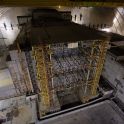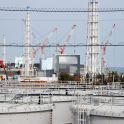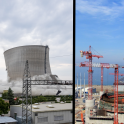News and press releases
GRS seeks to provide clear and careful communication. Our demands on the comprehensibility and quality of information are based on the Guidelines for good science PR.

36 years after the nuclear accident at Chernobyl

Once again, 11 March marks the anniversary of the nuclear accident at the Fukushima-Daiichi nuclear power plant in Japan. Several thousand workers are still doing their jobs on the plant site every month - primarily to prepare the dismantling of the destroyed reactors. On the occasion of the anniversary, we look back on the main events and developments of the past year in this article.

When it comes to further developments in nuclear engineering and new reactor concepts, the abbreviation SMR appears again and again. This article explains what is behind the term, gives an overview of some of the best-known concepts, and outlines the work of GRS on this topic.

On 10 February 2022, French President Emmanuel Macron explained to the public how he envisages France's energy supply for the next decades. In addition to large-scale new construction projects for offshore wind farms, the expansion of nuclear power in particular is intended to cover the electricity demand that will arise by 2050: Six new types of EPR2 reactors are to be built, and the construction of eight more is to be examined. In addition, the development of a so-called Small Modular Reactor and the long-term operation of older nuclear power plants are planned. What the new reactor types and long-term operation mean from a technical (safety) perspective is outlined below.

What has happened in the field of nuclear energy last year? What developments can be observed internationally? In 2021, a total of six new reactor units were connected to the grid, including one small modular reactor – on the other hand, ten units have been decommissioned, including three of the six German units that have remained until then. Accordingly, the installed net capacity decreased to a total of 388,600 megawatts.
GRS experts develop computational code that can be used to simulate muon radiographic images in order to test the suitability of the method for examining storage casks for spent fuel assemblies
On 31 December 2021, three of the remaining six German nuclear power reactor units will cease power operation: Brokdorf, Grohnde and Gundremmingen C. Brokdorf has been supplying electricity to the grid since December 1986, Grohnde and Gundremmingen C since the beginning of 1985 - together, these reactors have been in operation for over a hundred years. The final three units (Isar 2, Lingen and Neckarwestheim II) will be shut down on 31 December 2022.
"The Internet is on fire" – that was the message in mid-December 2021 when a security loophole in the Java framework log4j became known, making a wide range of cyber-attacks possible. The Federal Office for Information Security then raised a "red" alert, the highest warning level. Quite a number of companies around the world have turned out to be affected. On behalf of the Federal Ministry for the Environment, GRS experts are analysing cyber-attacks and security incidents that may also be relevant for German nuclear facilities and installations in order to protect them accordingly.

GRS publishes new version of its AC² code package
